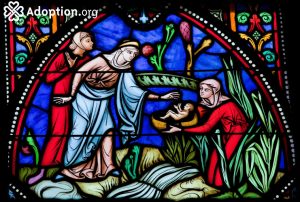Since the beginning of time, people and animals have instinctively cared for one another, even when they weren’t biologically related or the same species. Although “adoption” didn’t officially exist until much later, the practice got its roots from ancient times. When did adoption start? Here is a look at how adoption began and how it has evolved over the years.
According to the National Geographic article, “Why Animals ‘Adopt’ Others, Including Different Species,” unexpected alliances often form due to a combination of instinct, empathy and mutual benefit. Take the following examples. In 2013, sperm whales “adopted” a deformed bottlenose dolphin. Other unlikely pairings have also occurred throughout history, including a dog who nursed a baby squirrel as one of her own, captive apes that treated cats like their own babies, and a dog who watched over a baby owl. But when did adoption start for humans?
Humans are no different. Even back in Biblical times, a Hebrew woman named Jochebed placed her infant son in a basket and gently sent him down the river to save him. The reason? Pharaoh had ordered all Hebrew male infants be put to death. This woman did whatever she could to protect her child and give him a chance at life, much like today’s modern birth mothers. The baby was found by one of Pharaoh’s daughters, who “adopted” the child into the royal family and named him Moses. As you probably know, Moses later became an important leader and prophet. That answers the question, “When did adoption start?”
So how did adoption become what it is today? Check out this timeline:
- 1851 – The first modern adoption law, the Massachusetts Adoption of Children Act, is passed in the United States.
- 1891 – Michigan asks judges to investigate before entering final adoption decrees. This practice is later known as a “home study.”
- 1900 – Formal adoptions in a court are still rare.
- 1910-1930 – The first specialized adoption agencies are founded.
- 1917 – Minnesota passes the first state law requiring adoption records to be confidential. Investigation of potential foster homes becomes mandatory with the Minnesota Adoption Law of 1917.
- 1926 – Adoption legislation is passed in England.
- 1948 – The first recorded transracial adoption of an African-American child into a Caucasian home.
- 1950s – The term “home study” becomes common, although investigations of potential foster and adoptive homes had been going on for many years.
- 1950s – Proxy adoptions, where U.S. citizens can adopt children in foreign countries without being present, are the most common form of international adoptions.
- 1957 – Delaware bans non-agency adoptions.
- 1953-1962 – Americans adopt 15,000 foreign children.
- 1960s – Closed adoptions become more prevalent.
- 1962 – Connecticut bans non-agency adoptions.
- 1969 – President Nixon creates the Office of Child Development.
- 1970 – 20th-century adoption peaks, with approximately 175,000 adoptions finalized annually. About 80 percent of these were arranged by agencies.
- 1970s – The term “birth parent” is embraced by adoption reformers.
- 1976 – Concerned United Birthparents is founded.
- 1978 – Congress passes Indian Child Welfare Act, designed to protect Native American children from being removed from their families by public and private agencies. American Adoption Congress is founded.
- 1979 – A gay couple in California becomes the first in the country known to have jointly adopted a child.
- 1998 – Ballot Measure 58 is passed in Oregon, allowing adult adoptees to access their original birth certificates.
- 2000 – The Child Citizenship Act of 2000 is passed, allowing foreign-born adoptees to become automatic American citizens upon entering the United States.
- Today – About 135,000 children are adopted in the United States each year, and approximately 95 percent of adoptions involve some degree of openness or contact between birth parents and adoptive family.
Want to learn more about the history of adoption? Visit Adoption.com
Deanna Kahler is a proud mom and freelance writer with more than 20 years of professional experience. She has written for several adoption websites and is the author of the award-winning book, From Pain to Parenthood: A Journey Through Miscarriage to Adoption. When she’s not busy educating and inspiring others, Deanna enjoys hanging out in parks and on the shores of Michigan’s beautiful lakes. Check out her webpage at www.deannakahler.com.
